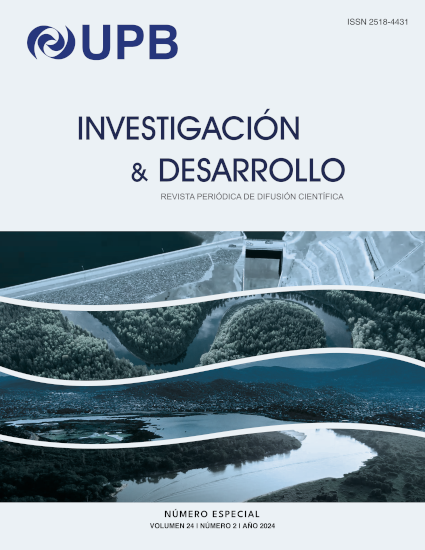EVALUACIÓN DE LA VULNERABILIDAD EN POZOS DEL VALLE CENTRAL DE COCHABAMBA
DOI:
https://doi.org/10.23881/idupbo.024.2-8iPalabras clave:
Aguas Subterráneas, Vulnerabilidad, DRASTICResumen
En el valle central de Cochabamba, el aumento de la población y la creciente demanda de agua para consumo humano, industrial y riego ha provocado un incremento en la cantidad de pozos perforados, elevando el riesgo de la contaminación de las aguas subterráneas. Por esta razón, se ha visto necesario identificar la vulnerabilidad a la contaminación de acuíferos en una zona productiva del valle central de Cochabamba, para el cual se ha utilizado la herramienta DRASTIC. El método considera la combinación de siete factores hidrogeológicos utilizando herramientas SIG para los cuales se ha alimentado con información hidrogeológica local y actualizada. Para obtener el índice de vulnerabilidad se han analizado cuatro escenarios en base a los pesos asignados a cada factor. Los resultados indican que los factores con mayor afectación son la profundidad del nivel estático, la geología del acuífero, el impacto en la zona vadosa, la recarga y el tipo de suelo. La zona norte presenta vulnerabilidad Media Alta al ser zona de recarga con pozos profundos, la zona central indica vulnerabilidad Alta a Muy Alta por la presencia de pozos surgentes y actividades agrícolas, y la zona sur presenta de forma general vulnerabilidad Baja a Media Baja al ser una zona de descarga, urbanizada, acuíferos confinados y niveles de agua profundos. Por tanto, se recomienda dar un mayor énfasis a la zona norte y zona central, validar con estudios hidrogeoquímicos, elaborar planes de gestión, al igual que emplear el esquema propuesto en otras zonas de gran interés hidrogeológico.Descargas
Referencias
J. E. Cabrera, A. Alarcon, H. Terraza, D. Maleki, and S. Lew, "Plan de acción: Área metropolitana de Cochabamba sostenible," ICES - Banco Interamericano de Desarrollo, 2013. [Online]. Available: https://doi.org/10.13140/RG.2.1.1673.4961.
Instituto Nacional de Estadística (INE), "Proyecciones de Población, Revisión 2020," Población y Hechos Vitales. [Online]. Available: https://www.ine.gob.bo/index.php/censos-y-proyecciones-de-poblacion-sociales/
Ministerio de Medio Ambiente y Agua (MMAyA), Gobierno Autónomo Departamental de Cochabamba (GADC), and Servicio Departamental de Cuencas (SDC), "Formulación y Actualización del Plan Director de la cuenca del río Rocha, bajo un enfoque de adaptación y Cambio Climático," 2018. [Online]. Available: https://www.sei.org/wp-content/uploads/2020/02/resumen-ejecutivo-r%C3%ADo-rocha.pdf.
L. Rosales, O. C. Saavedra, and W. Soruco, "Modelación hidrológica en un abanico aluvial de Cochabamba-Bolivia," Investig. Desarro., vol. 20, no. 1, pp. 51-66, Jul. 2020. doi: 10.23881/idupbo.020.1-4i.
S. Renner and C. Velasco, "Geología e hidrología del Valle Central de Cochabamba," Servicio Nacional de Geología y Minería (Bolivia), 2000.
B. López, L. Rosales, and O. Saavedra, "Modelación hidrogeológica en el Valle Central de Cochabamba-Bolivia," Investigación & Desarrollo, vol. 23, no. 1, Jul. 2023. doi: 10.23881/idupbo.023.1-2i.
M. Albinet and J. Margat, "Groundwater pollution vulnerability mapping," Bull. Bur. Res. Geol. Min., vol. 3, pp. 13-22, 1970.
I. Árcega, E. Otazo, E. Galindo, O. Acevedo, and C. Romo, "Determinación del índice de vulnerabilidad mediante el método DRASTIC," Rev. Iberoam. Ciencias, vol. 2, no. 7, pp. 39-49, 2015.
A. Barbulescu, "Assessing groundwater vulnerability: DRASTIC and DRASTIC-like methods: A review," Water, vol. 12, no. 5, p. 1356, May 2020. doi: 10.3390/w12051356.
L. Aller and J. Thornhill, "DRASTIC: a standardized system for evaluating ground water pollution potential using hydrogeologic settings," Robert S. Kerr Environmental Research Laboratory, 1987.
National Research Council (NRC), "Ground water vulnerability assessment: Predicting relative contamination potential under conditions of uncertainty," National Academies Press, 1993.
L. Aller, T. Bennett, J. H. Lehr, R. J. Petty, and G. Hackett, "DRASTIC: A standardized system for evaluating groundwater pollution potential using hydrogeologic settings," Robert S. Kerr Environmental Research Laboratory, Office of Research and Development, US Environmental Protection Agency, 1987.
Servicio Nacional de Meteorología e Hidrología (SENAMHI), "Información Nacional de Datos Hidrometeorológicos - INADHI," [Online]. Available: https://senamhi.gob.bo/index.php/sysparametros. Accessed: Oct. 29, 2023.
Universidad Privada Boliviana (UPB), "Estación Meteorológica UPB," [Online]. Available: http://weatherst.lrc.upb.edu/. Accessed: Oct. 29, 2023.
U.S. Geological Survey (USGS), "ASTER Mount Gariwang image from 2018," 2018. [Online]. Available: https://lpdaac.usgs.gov/user_resources/data_in_action/aster_ultimate_2018_winter_olympics_observer. Accessed: Oct. 29, 2023.
S. M. Shirazi, H. M. Imran, and S. Akib, "GIS-based DRASTIC method for groundwater vulnerability assessment: a review," J. Risk Res., vol. 15, no. 8, pp. 991-1011, Sep. 2012. doi: 10.1080/13669877.2012.686053.
F. A. L. Pacheco, L. M. G. R. Pires, R. M. B. Santos, and L. F. Sanches Fernandes, "Factor weighting in DRASTIC modeling," Sci. Total Environ., vol. 505, pp. 474-486, Feb. 2015. doi: 10.1016/j.scitotenv.2014.09.092.
K. Musálem, M. McDonald, F. Jiménez, and R. Laino, "Mapeo de la vulnerabilidad del agua subterránea en dos cuencas afectadas por la represa Yacyreta en Paraguay," Tecnol. Cienc. Agua, vol. 6, no. 6, pp. 49-61, 2015.
Descargas
Archivos adicionales
Publicado
Número
Sección
Licencia
Derechos de autor 2025 Laura Rosales, Oliver Saavedra, Brayan López, Jhonatan Ureña

Esta obra está bajo una licencia internacional Creative Commons Atribución-NoComercial-CompartirIgual 4.0.
Reconocimiento-NoComercial-CompartirIgual
CC BY-NC-SA
Esta licencia permite a otros entremezclar, ajustar y construir a partir de su obra con fines no comerciales, siempre y cuando le reconozcan la autoría y sus nuevas creaciones estén bajo una licencia con los mismos términos.
Los autores pueden realizar acuerdos contractuales adicionales separados para la distribución no exclusiva de la versión publicada del artículo publicado en la revista (por ejemplo, publicarlo en un repositorio institucional o en un libro), sujeto a un reconocimiento de su publicación inicial en esta revista
